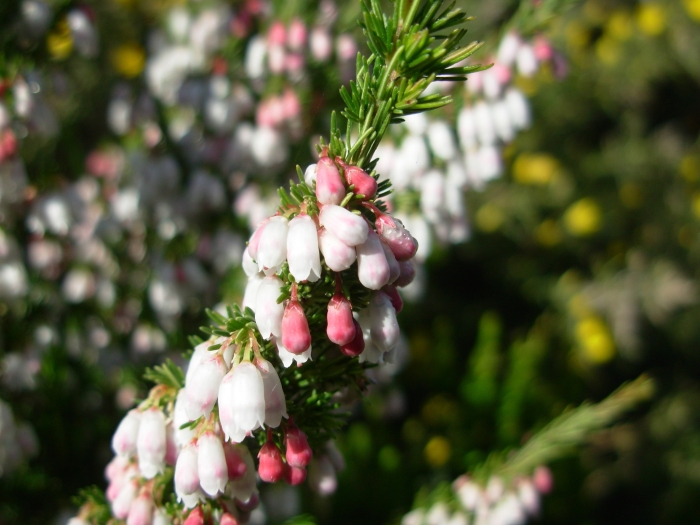Portuguese Heath
(Erica lusitanica)
Portuguese Heath (Erica lusitanica)
/
/

Tony Wills
CC BY-SA 4.0
Image By:
Tony Wills
Recorded By:
Copyright:
CC BY-SA 4.0
Copyright Notice:
Photo by: Tony Wills | License Type: CC BY-SA 4.0 | License URL: http://creativecommons.org/licenses/by-sa/4.0/ | Rights Holder: Tony Wills | Publisher: iNaturalist | Date Created: 2013-07-29T04:50:47-07:00 |

























Estimated Native Range
Summary
Erica lusitanica, commonly known as Portuguese Heath, is an evergreen shrub native to the heathlands and open woodlands of southwestern Europe, particularly in Portugal and Spain. It can also be found in scrub habitats. This plant typically grows at a moderate rate to a height and width of 4-6 feet (1.2-1.8 meters). Portuguese Heath is characterized by its dense, bushy form and profuse white or pink flowers, which are quite showy and bloom in winter and spring, providing color during a time when few other plants are in flower.
Portuguese Heath is valued for its winter and spring blooms, which can brighten up gardens during the colder months. It is also appreciated for its ease of maintenance and tolerance of different soil types. Commonly used in rock gardens, as a ground cover, or in borders, it can also be effective in preventing soil erosion. Erica lusitanica requires full sun to part shade and prefers medium or fast-draining clay, loam, or sandy soils. It is drought-tolerant once established and has medium water needs. While generally disease-free, it can be susceptible to root rot if overwatered or planted in poorly draining soils. Gardeners should be cautious as Erica lusitanica can become invasive outside its native range, so it is essential to consult local guidelines before planting.CC BY-SA 4.0
Portuguese Heath is valued for its winter and spring blooms, which can brighten up gardens during the colder months. It is also appreciated for its ease of maintenance and tolerance of different soil types. Commonly used in rock gardens, as a ground cover, or in borders, it can also be effective in preventing soil erosion. Erica lusitanica requires full sun to part shade and prefers medium or fast-draining clay, loam, or sandy soils. It is drought-tolerant once established and has medium water needs. While generally disease-free, it can be susceptible to root rot if overwatered or planted in poorly draining soils. Gardeners should be cautious as Erica lusitanica can become invasive outside its native range, so it is essential to consult local guidelines before planting.CC BY-SA 4.0
Plant Description
- Plant Type: Shrub
- Height: 4-6 feet
- Width: 4-6 feet
- Growth Rate: Moderate
- Flower Color: White, Pink
- Flowering Season: Winter, Spring
- Leaf Retention: Evergreen
Growth Requirements
- Sun: Full Sun, Part Shade
- Water: Medium
- Drainage: Medium, Fast
Common Uses
Border Plant, Butterfly Garden, Deer Resistant, Low Maintenance, Rock Garden, Showy Flowers
Natural Habitat
Heathlands and open woodlands of southwestern Europe
Other Names
Common Names: Spanish Heath, Spear Heath, Urze, Lusitanian Heath
Scientific Names: , Erica lusitanica, Erica codonoides,
GBIF Accepted Name: